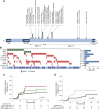Frequent ASXL2 mutations in acute myeloid leukemia patients with t(8;21)/RUNX1-RUNX1T1 chromosomal translocations
- PMID: 24973361
- PMCID: PMC4148766
- DOI: 10.1182/blood-2014-04-571018
Frequent ASXL2 mutations in acute myeloid leukemia patients with t(8;21)/RUNX1-RUNX1T1 chromosomal translocations
Abstract
Acute myeloid leukemia (AML) with t(8;21) (q22;q22) is considered to have favorable risk; however, nearly half of t(8;21) patients are not cured, and recent studies have highlighted remarkable genetic heterogeneity in this subset of AML. Here we identify somatic mutations in additional sex combs-like 2 (ASXL2) in 22.7% (25/110) of patients with t(8;21), but not in patients with inv(16)/t(16;16) (0/60) or RUNX1-mutated AML (0/26). ASXL2 mutations were similarly frequent in adults and children t(8;21) and were mutually exclusive with ASXL1 mutations. Although overall survival was similar between ASXL1 and ASXL2 mutant t(8;21) AML patients and their wild-type counterparts, patients with ASXL1 or ASXL2 mutations had a cumulative incidence of relapse of 54.6% and 36.0%, respectively, compared with 25% in ASXL1/2 wild-type counterparts (P = .226). These results identify a high-frequency mutation in t(8;21) AML and identify the need for future studies to investigate the clinical and biological relevance of ASXL2 mutations in this unique subset of AML.
© 2014 by The American Society of Hematology.
Figures

Comment in
-
ASXL genes and RUNX1: an intimate connection?Blood. 2014 Aug 28;124(9):1382-3. doi: 10.1182/blood-2014-07-586073. Blood. 2014. PMID: 25170110 Free PMC article.
References
-
- Vardiman JW, Thiele J, Arber DA, et al. The 2008 revision of the World Health Organization (WHO) classification of myeloid neoplasms and acute leukemia: rationale and important changes. Blood. 2009;114(5):937–951. - PubMed
-
- Grimwade D, Hills RK, Moorman AV, et al. National Cancer Research Institute Adult Leukaemia Working Group. Refinement of cytogenetic classification in acute myeloid leukemia: determination of prognostic significance of rare recurring chromosomal abnormalities among 5876 younger adult patients treated in the United Kingdom Medical Research Council trials. Blood. 2010;116(3):354–365. - PubMed
-
- Marcucci G, Mrózek K, Ruppert AS, et al. Prognostic factors and outcome of core binding factor acute myeloid leukemia patients with t(8;21) differ from those of patients with inv(16): a Cancer and Leukemia Group B study. J Clin Oncol. 2005;23(24):5705–5717. - PubMed
-
- Schlenk RF, Benner A, Krauter J, et al. Individual patient data-based meta-analysis of patients aged 16 to 60 years with core binding factor acute myeloid leukemia: a survey of the German Acute Myeloid Leukemia Intergroup. J Clin Oncol. 2004;22(18):3741–3750. - PubMed
-
- Hatlen MA, Wang L, Nimer SD. AML1-ETO driven acute leukemia: insights into pathogenesis and potential therapeutic approaches. Fr Medecine. 2012;6(3):248–262. - PubMed
Publication types
MeSH terms
Substances
Grants and funding
LinkOut - more resources
Full Text Sources
Other Literature Sources
Medical

